You need to make efforts every time you post a new article to get significant traffic to your website and increase its visibility. With ranking algorithms often being tested and Google introducing new features, SEO experts are often challenged to keep up.
Although not being an innovation at all, featured snippets are gaining popularity, and it seems it’s only the beginning. Winning a featured snippet impacts your brand success a lot.
According to Ben Goodsell, the revenue of the featured content from organic traffic increases by 677%.
In this post, I’ll tell you about the essential steps for you to take if you want to win featured snippets for your content.
Why you should optimize for featured snippets
Striving to get a featured snippet isn’t an easy task. The first thing you should know is that you can never be sure whether Google considers your website to be good enough to become a featured snippet or not. But it doesn’t mean you shouldn’t try. Even the small chance to win a featured snippet is worth optimizing for it. Here are the main advantages of being a featured snippet.
Voice search
Voice search results provide users with only one answer, the most relevant answer. So, being on page one of Google doesn’t guarantee your website will be represented for voice search users. You need to be the best of the best… or try to win a featured snippet.
Backlinko discovered 40.7% of all voice search results come from a featured snippet. By the way, being a featured snippet doesn’t mean taking the first position of the search results. If, for example, you rank number three in search results but won a featured snippet, it’s most likely that the voice assistant preferred your answer.
People also ask
Here’s the advantage I’ve discovered almost accidentally. Do you remember ‘People also ask’ box? This box often appears among the search results for a specific query.
Once a person investigating some topic finds the questions Google suggests interesting enough, he or she may click on the question. If there’s a featured snippet for this query, Google will immediately provide a user with the featured result and a link to the website.
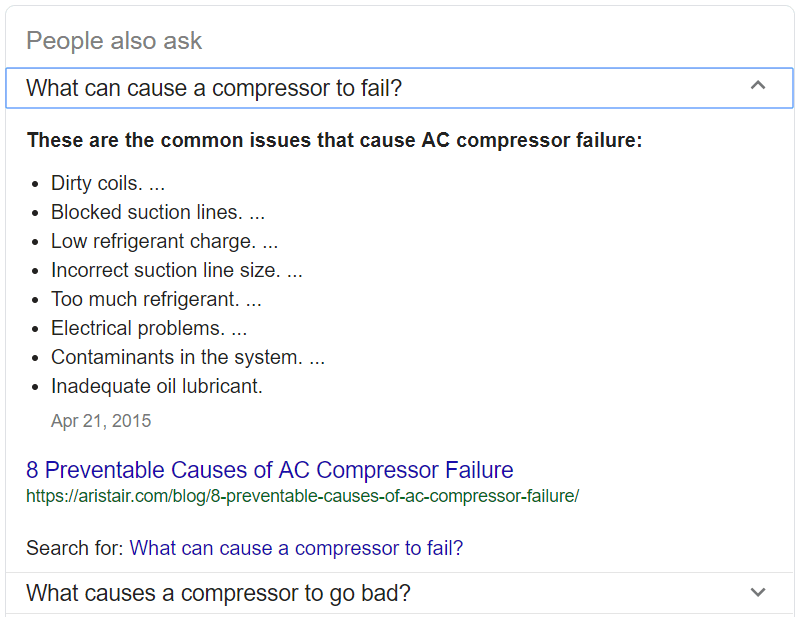
What’s the most interesting is that following the ‘What can cause a compressor to fail?’ query, you’ll see completely different snippet with another link.
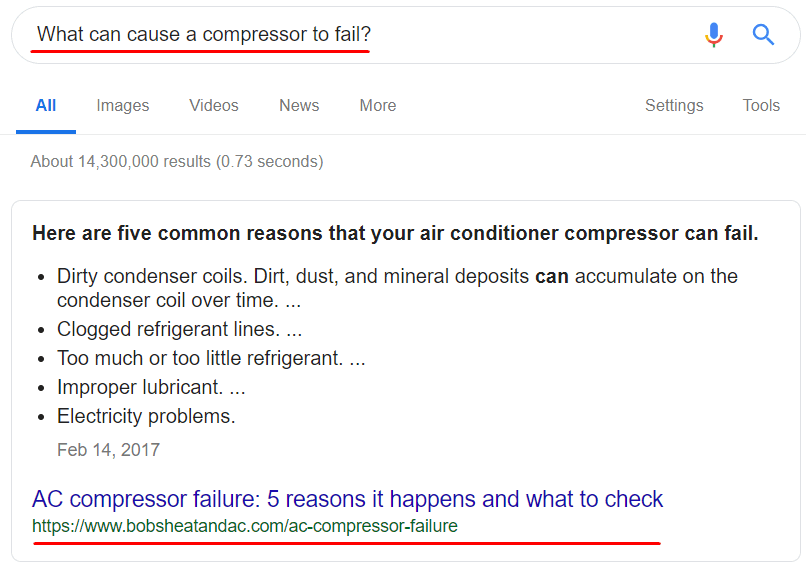
So don’t despair if you don’t see your website in a featured snippet for a query, maybe it became featured for ‘People also ask for’ box?
Credibility
Although Ahrefs research has shown that featured snippets don’t attract a lot of clicks, they concluded that providing a comprehensive answer featured snippet doesn’t require clicking through it. People tend to trust the featured snippets.
So, if you want to improve the click through rate, perhaps, this strategy isn’t for you. But in case you want to increase your brand awareness and credibility, appearing in featured snippets will help you with it.
Let’s come back to clicks
Yes, the number of clicks featured snippets get isn’t that significant. But who said it isn’t worth taking efforts?
According to Ahrefs study, the first search result with no featured snippet normally gets ~26% of all clicks. But when there’s a featured snippet in the first position, it gets ~8.6% of clicks, while the page ranking below it gets other 19.6% of clicks. It means that although your snippet may not attract a huge number of clicks, it steals them from your closest competitor.
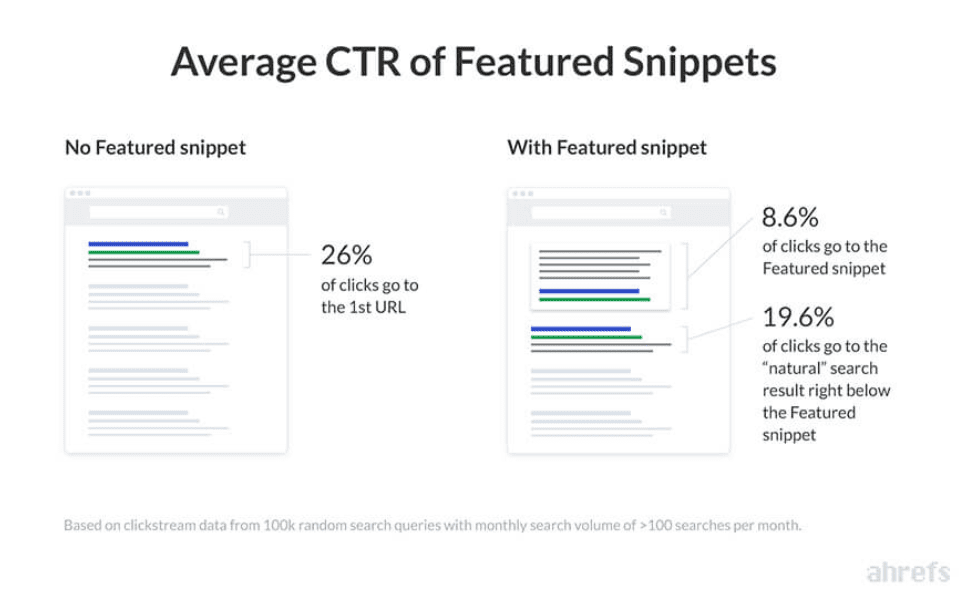
How to optimize for featured snippets
Now, when I’ve convinced you of the obvious advantages of featured snippets (hopefully), it’s time to discover the steps you need to get into a featured snippet.
Before you start
First and foremost, mind that only those pages which appear on the first page of search results can compete for a featured snippet. That’s why your primary goal should be ranking on page one of Google. At this point, you should start with proper keyword research. Here’s a step-by-step guide to researching keywords.
Keyword research
Your ‘how to win featured snippet’ strategy depends on what positions you’re currently ranking for.
1. If your website doesn’t show up on the first page
If you fail to rank high for the keywords you choose, maybe it’s time to think of the keywords with a lower difficulty level? For instance, if you wrote an apple pie recipe, there’s already a lot of competition for the ‘apple pie recipe’ query. But let’s go further. Using Ahrefs or Serpstat Keyword Research tool, you can identify which phrases related to your subject will be the most appropriate for you. Type the keywords best describing your topic, and here’s what you’ll see:
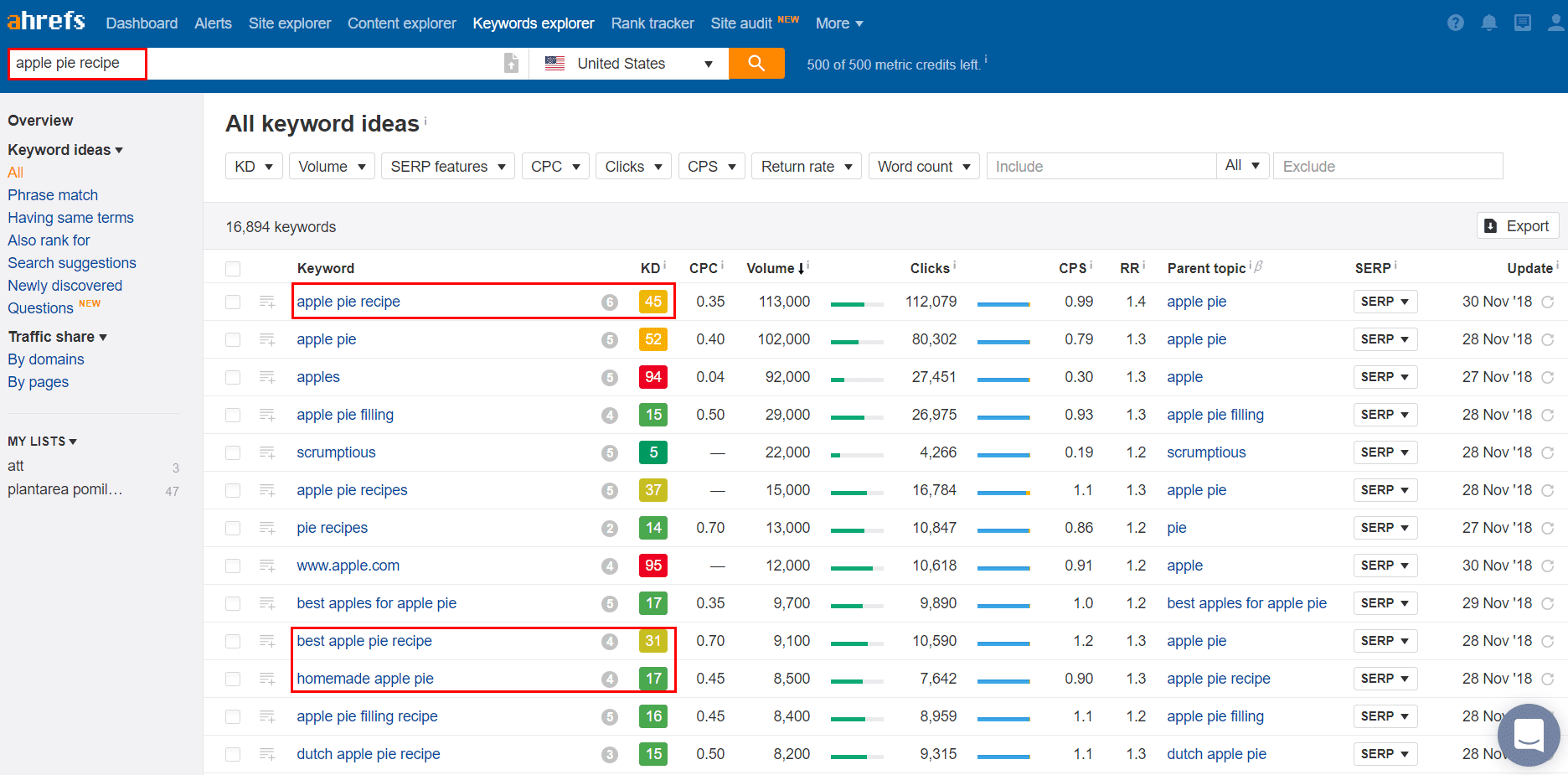
As ‘apple pie recipe’ keyphrase has quite a significant difficulty level, there are such queries as ‘best apple pie recipe’ and ‘homemade apple pie’ with 31 and 17 scores. Selecting relevant but not that high volume keywords can help you hit the first page, and gradually increase the difficulty level. Once you’ve started to rank high on Google, you can move on to the next paragraph.
2. If your website shows up on the first page
At this stage, you should optimize your keyword research to increase the opportunity to get featured snippets. Start from focusing on the questions. Queries with ‘how to,’ ‘what is,’ ‘when,’ etc… result in featured snippets most often. And it’s not surprising: such queries require concise and clear answers which can be easily represented in a few sentences or a list. To discover which questions people use to search for the related subject, you can take several steps:
- Check ‘People also ask’ box. If you search for ‘homemade apple pie’, you’ll see such a box among the results:

Tapping on the arrows near the questions, you’ll be provided with more and more suggestions:
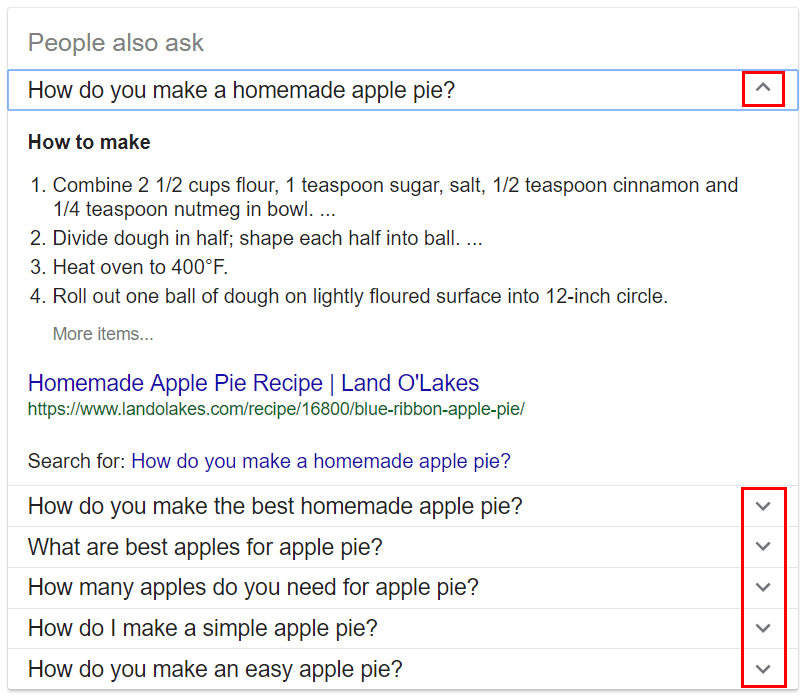
- Use Answer The Public. The service will show you the most asked questions on your topic:
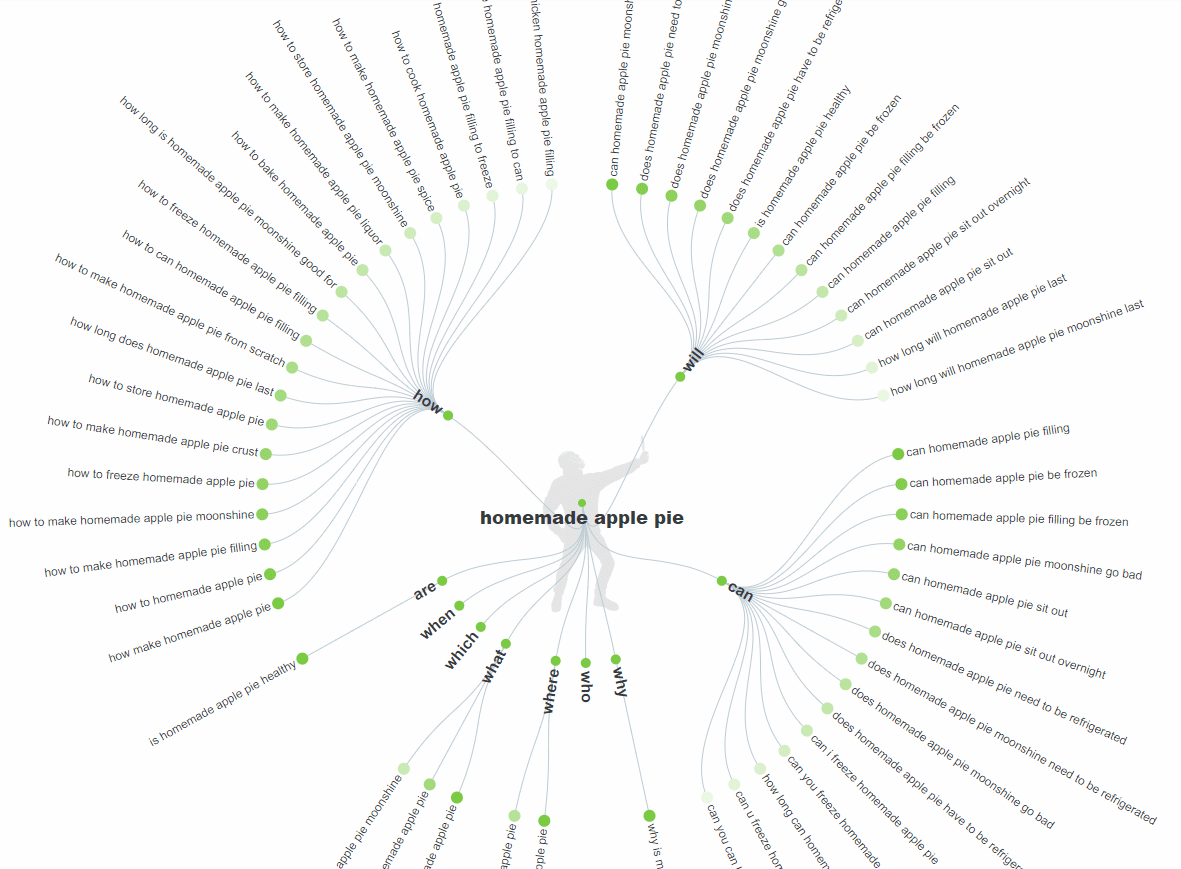
When you’ve collected the questions your topic can cover, it’s time to select other long-tail keywords. Although questions take a significant place in the process of optimization for featured snippets, you shouldn’t exclude queries not containing question words.
Firstly, the number of such queries still prevail. Secondly, you can implement these long-tail keywords into your answers to the search questions your website ranks for.
After you’ve conducted your keyword research, you need to implement the phrases you’ve selected into your new or existing content. To discover which posts are worth improving, go to Serpstat > Domain Analysis > SEO Research > Positions.
There you should pay attention to the keywords your pages already rank for in top 10 of the search results. If you are a free user, select the queries providing featured snippets manually: hover over the ‘Special blocks in SERP’, and you’ll see whether there’s a featured snippet.
In case you have Plan A or higher, you can simply apply a filter to see the search results containing featured snippets. This data will help you identify the content you should optimize first of all to try to win featured snippets.
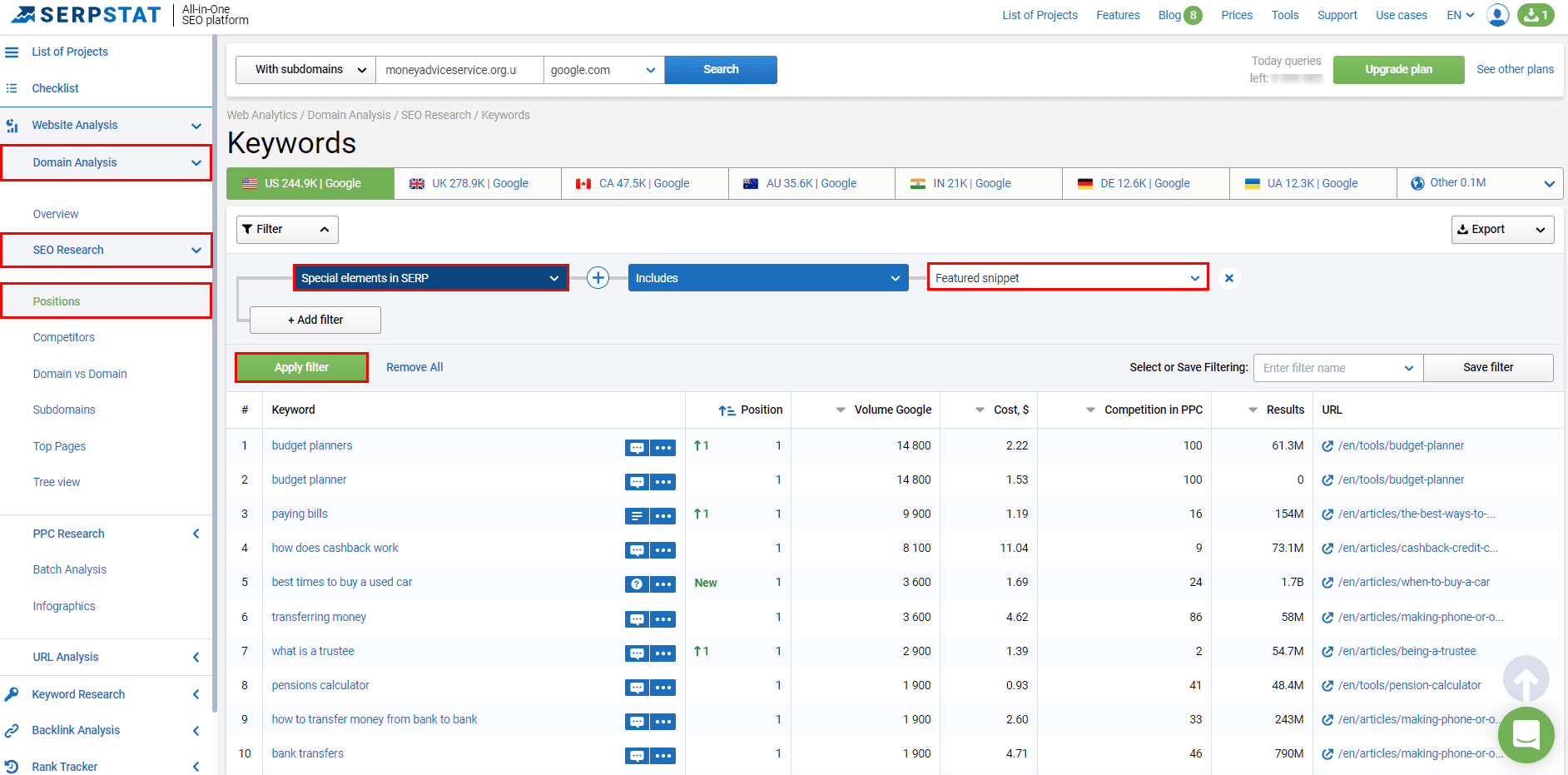
Structured content
The more clear structure you provide, the more chances there are for your page to get a featured snippet. If you look at the most featured snippets, you’ll see they contain numbers, lists, the steps you should undertake, etc…
Your content should consist of short paragraphs. By formatting your content, you make it easier both for users and for search engines to identify the most important data.
Use the questions in your headers. Headers may not only help you divide your text into paragraphs, but they’re also an excellent place to use the keywords you want your page to rank for. If your article answers a question, use this question in the header.
Focus on as many questions as possible
If your content gets a featured snippet for one search query, the chances to win featured snippets for other similar ones are great enough. As your site already has an appropriate structure to provide a quick answer, it’s more likely Google will consider it to be a great option for the related queries.
Answer as many related queries as possible. For instance, when you write about how to clean a teapot, there are various types of queries your content may rank for (as well as get a featured snippet).
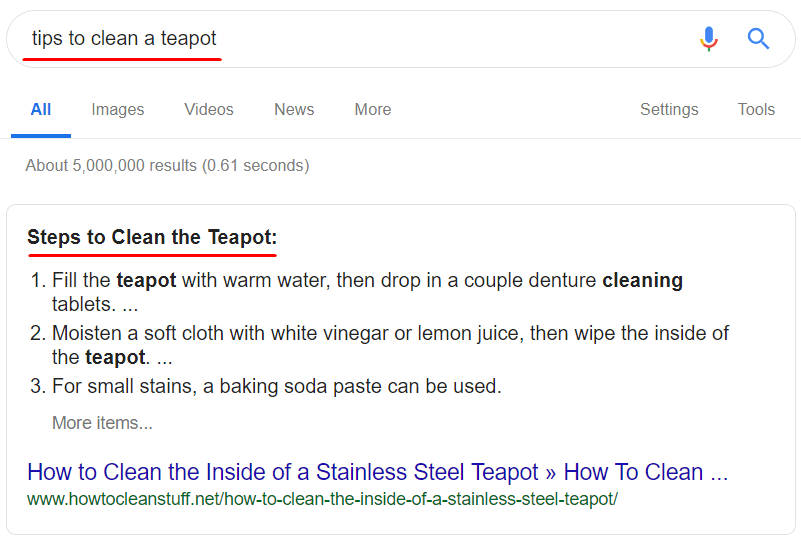

One more idea is to build your content in the FAQ style to cover multiple questions people may have on your topic.
Provide clear answers
After you’ve identified the queries you want your page content to rank for, provide the answers to these queries. The shorter and the more concise these answers will be, the more chances there are for the content to get into a featured snippet.
For example, if you give tips on how to choose a smartphone, make a list so it’s clear what steps are required in the process. Here’s what it should look like on the page:
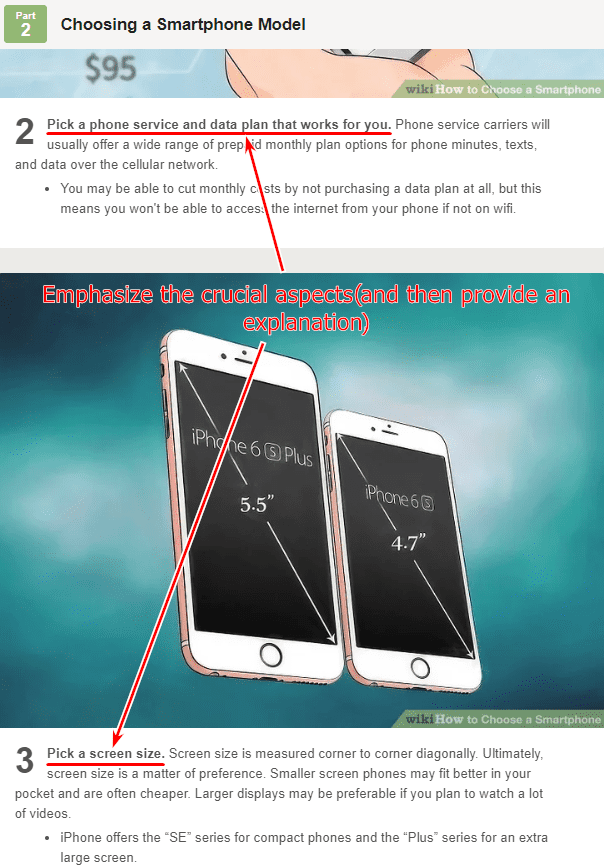
Of course, the whole post should be comprehensive. But to make your answer clear and easy-to-understand, emphasize the most crucial aspects to help Google form a featured snippet from your content:
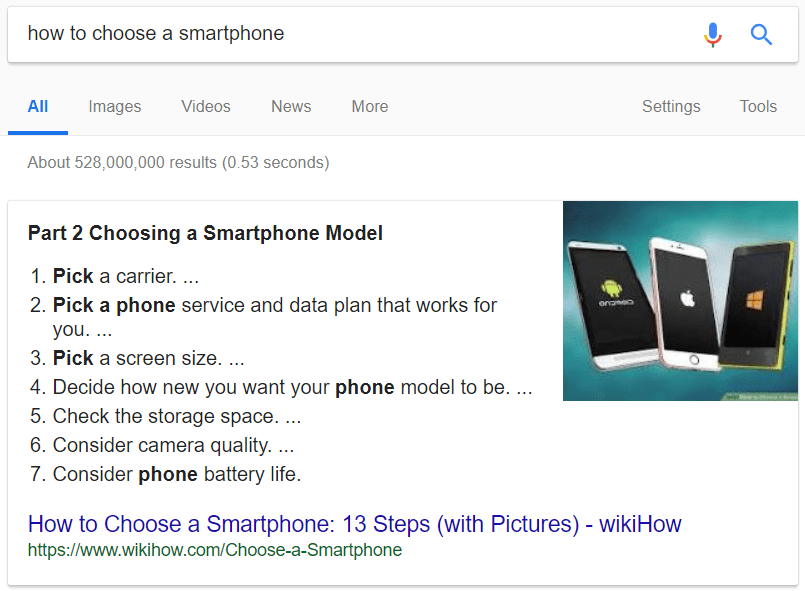
Visual content
Isn’t it obvious that catchy images attract users? Although Google provides featured snippets with images, you can never predict which one the search engine will choose. I’ve conducted a ‘how to write a letter’ query, and here’s what I’ve seen in the featured snippet:
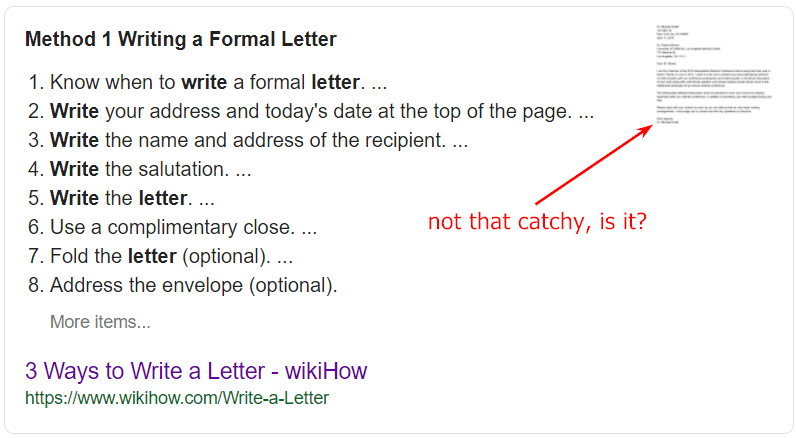
Although there were lots of branded images at the beginning of each paragraph, Google selected the sample letter to illustrate the content. So, when you provide visual content for your article, you should not only provide high-quality pictures but also make sure nothing can prevent Google from choosing those you’d like to see in your featured snippets.
Summary
On your way to winning a featured snippet, your first step should be optimizing your content to rank top 10 in search results. Once it isn’t a big deal for you anymore, you can concentrate on the nuances necessary for getting a featured snippet. These are question-based and long tail keywords, clear structure, comprehensive content, etc…
When you understand what can make your content become a featured snippet, you’ll learn how to improve your online engagement and enhance user experience.




